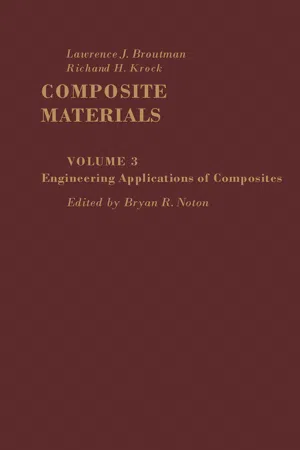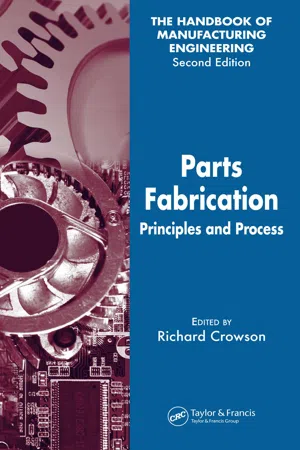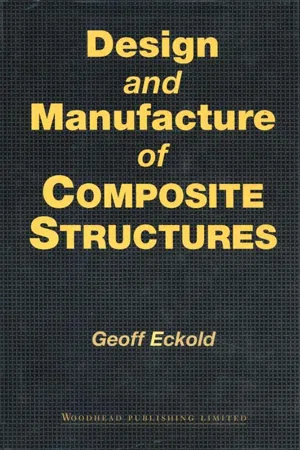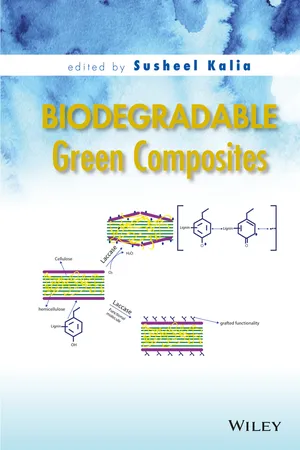Technology & Engineering
Applications of Composite Materials
Composite materials are widely used in various industries due to their unique properties, such as high strength-to-weight ratio, corrosion resistance, and design flexibility. They are commonly applied in aerospace, automotive, marine, construction, and sports equipment. These materials offer opportunities for lightweight and durable solutions in a wide range of engineering applications.
Written by Perlego with AI-assistance
Related key terms
1 of 5
10 Key excerpts on "Applications of Composite Materials"
- eBook - PDF
- T. W. Clyne, D. Hull(Authors)
- 2019(Publication Date)
- Cambridge University Press(Publisher)
Furthermore, while steel and timber can be regarded as commodities, with much of their consumption occurring along a relatively small number of well-defined pathways, composite mater- ials are very diverse and are used in a huge variety of applications and industrial sectors. While the reasons for selecting composite materials can vary somewhat between sectors, the attractions of low weight, high specific stiffness, good toughness, excellent corrosion resistance and high mouldability are relevant to many applications. They are thus the automatic materials of choice for many components in industries as diverse as aerospace, marine, automotive, sports goods, wind energy, construction, fluid storage and transmission, and more. Furthermore, usage is projected to expand in virtually all of these areas. The situation regarding metal matrix composites (MMCs) and ceramic 319 matrix composites (CMCs) is a little different, since the markets in which their usage has become established are much more limited and the situation is in general more fluid. Nevertheless, the applications described below include several (in the section on high- temperature applications) that concern MMC and CMC usage and a number of other possible areas of exploitation are being actively investigated. While there is no prospect of such composites being used on a scale comparable to that of polymer matrix composites (PMCs), they are of commercial significance and their efficient usage requires an understanding of their characteristics in the context of composite theory. 16.2 Aerospace and Automotive Applications There are many aerospace and automotive applications for which combinations of lightness, stiffness and strength are highly attractive. A graphic illustration of this is provided by Fig. 16.1, which shows a human-powered aircraft in flight. Virtually all of the components involved are composites of various types (mostly based on carbon fibre). - eBook - PDF
- Bipin Kumar, Suman Thakur, Bipin Kumar, Suman Thakur(Authors)
- 2017(Publication Date)
- IntechOpen(Publisher)
Various textile production methods used for the formation of textile preforms are explained. Composite fabrication methods are introduced. Engineering properties of textile composites are reviewed with regard to specific application areas. The latest developments and future challenges for textile-reinforced composites are presented. Keywords: textile-reinforced composites, fiber architectures, textile production methods, advanced applications, engineering properties © 2017 The Author(s). Licensee InTech. This chapter is distributed under the terms of the Creative Commons Attribution License (http://creativecommons.org/licenses/by/3.0), which permits unrestricted use, distribution, and reproduction in any medium, provided the original work is properly cited. 1. Introduction A composite material can be defined as a combination of a reinforcement material and a matrix. The properties of a composite are superior to the properties of the individual compo-nents. Reinforcement is the main load-bearing component and is responsible for the strength and stiffness of the composite material. Reinforcement forms include fibers, particles, and flakes. Matrix, on the other hand, keeps the reinforcement in a given orientation and pro -tects it from chemical and physical damage. It is also responsible for the homogeneous dis-tribution of an applied load between the reinforcement elements. Composite materials are generally employed when traditional materials such as metals, ceramics, and polymers do not satisfy the specific requirements of a certain application. One of the main advantages of composite materials is that they can be designed to obtain a wide range of properties by altering the type and ratios of constituent materials, their orientations, process param-eters, and so on. Composites also have high mechanical properties with a low weight which makes them ideal materials for automotive and aerospace applications. - eBook - ePub
Green Composites
Polymer Composites and the Environment
- Caroline Baillie, Randika Jayasinghe(Authors)
- 2004(Publication Date)
- Woodhead Publishing(Publisher)
11Applications
M. Hughes University of Wales, UK11.1 Introduction and definitions
For millennia, humans have used materials readily available to them – stone, clay, mud, wood, bone and hide, for example – and have fashioned these to suit their purposes. With the coming of the industrial revolution in the eighteenth century and importantly, with the development of synthetic resins and plastics in the late nineteenth and early twentieth centuries, skill in the use of these natural resources has gradually declined. We now live in an age where we are generally unfamiliar with many of these traditional materials, to the extent that ‘natural’ materials are sometimes regarded with some misgiving and may indeed be viewed as being, in some way, inferior to the synthetic materials available to us today. Increasingly, however, we are becoming aware of the need to reduce the adverse effects of our activities upon the environment and, as a result, renewed interest is being shown in ‘traditional’ or ‘natural’ materials, particularly those that are derived from renewable resources.Composites are an important class of engineering materials that are finding increasing use in applications ranging from leisure goods to construction. Their excellent specific properties make them particularly attractive for applications in which weight saving is advantageous, such as transportation and aerospace. Nevertheless, despite their undoubted ubiquity, they exact a heavy price in environmental terms. Problems with end-of-life disposal and non-renewable, fossil-based raw materials are considered to be particularly challenging and are leading to resurgent interest in composite materials based upon natural, renewable resources.This chapter sets out to review and discuss applications for composites based upon renewable resources, so-called ‘green’ composites. To this end, the historical applications for these materials will highlighted and some examples of the early uses of green composites, at the dawn of the synthetic polymer age in the early twentieth century, will be given. The focus, however, will be on current and future potential applications for these materials and will include likely trends in usage. As with all materials there are limitations which will effectively govern the range of potential end uses; these limitations will be highlighted in the context of intended applications. Whilst there are certain technical barriers hindering the widespread adoption of these materials, there are also a number of market and consumer issues which will, in the short to medium term, affect the uptake of these materials. These issues will also be highlighted and discussed. Myths: over the past few years there has been much written about the potential for high performance composites based on natural fibres. Much of the early optimism about composite performance has now been replaced with a more realistic view of what can be achieved in performance terms. Nevertheless, there is still significant scope for performance improvement and whilst green composites may not find use in aircraft primary structures (although they nearly did…!), there is a raft of structural or semi-structural applications for which they may well be entirely suitable. - eBook - PDF
Engineering Applications of Composites
Composite Materials, Vol. 3
- Bryan R. Noton(Author)
- 2016(Publication Date)
- Academic Press(Publisher)
In several cases, the hardware discussed has already been commercialized. Experience and customer confidence is therefore rapidly being acquired. I. Introduction The first applications of advanced composites were for military projects. Besides material cost, the complexity and cost of fabrication have prevented a number of applications from being committed to production. In the cases where series production has been observed, advanced composites were frequently employed as flat or moderately curved sheets bonded to honey-comb cores, thereby reducing fabrication problems. The benefits to be derived from the use of advanced composites in the commercial markets discussed in this chapter cannot be over-emphasized. The benefits included reduction of material cost, development of mechanized fabrication processes, customer confidence and acceptance, and also experience from a variety of operating conditions and environmenis. The approach being taken to utilize advanced composite materials is as follows. First, conventional materials, such as glass-reinforced plastics are being selectively reinforced; in many cases with a negligible increase in cost of fabrication. Second, woven forms and standard pultruded members of L and Z sections are being produced. The designer, assembly shops, and customers are familiar with these sections and this eases the problems normally encountered when introducing a new material. Third, new innovative design concepts for more complex components are under development. These use adhesive bonding extensively, and besides being developed to reduce weight have also as important goals the reduction of 13. Advanced Composites 465 fabrication cost, development of high fiber-loading efficiencies, and may also possess special characteristics such as crack arresters. II. Standard Structural Sections In Appendix II some of the blockages to the incorporation of emerging materials are discussed. - eBook - PDF
Parts Fabrication
Principles and Process
- Richard Crowson(Author)
- 2006(Publication Date)
- CRC Press(Publisher)
229 Composite Manufacturing John F. Maguire with Don Weed and Thomas J. Rose 6.0 INTRODUCTION AND BACKGROUND It is difficult to find a truly satisfactory definition of composite material. The American Heritage Dictionary (Houghton Mifflin, Boston, 1981) comes close, with “a complex material, such as wood or fiber glass, in which two or more complementary substances, especially metals, ceramics, glasses, and polymers, combine to produce some structural or functional properties not present in any individual component.” The problem with even a good definition, of course, is that it is all-encompassing, so that every material in the universe could in some sense be defined as a composite. This loss of exclusivity diminishes the usefulness of the definition. For our purposes, we shall restrict attention to that subset of materials known as fiber-reinforced advanced polymeric composites. In these materials, a reinforcing fiber is embedded in an organic polymeric resin. The fiber acts as a structural reinforcement and the resin binds the fibers together. This transfers loads and provides structural and dimensional integrity. Advanced composite materials, developed in the latter half of the twentieth cen-tury, may well provide a key to enabling technology for the twenty-first century. These materials are strong, light, and corrosion resistant, offering considerable tech-nical advantages in aerospace, automotive, offshore petrochemical, infrastructure, and other general engineering applications. Composite components may be made by laminating or laying up layers of composite material, each ply consisting of one or more patterns, which may be as large as 4 1/2 ft wide by 9 ft long. These patterns are cut from a continuous roll of cloth, or from sheets, with standard widths measuring up to 4 1/2 ft. Composite material wider than 12 in. is referred to as broadgoods. If a material is narrower, it is usually a unidirectional tape. In such a tape the fibers run 6 - eBook - ePub
- G C Eckold(Author)
- 1994(Publication Date)
- Woodhead Publishing(Publisher)
Although there is a wide usage of plastics in the automotive industry, applications are somewhat restricted to non-safety critical components. The majority of current use is in thermoplastic injection moulded trim items. There is increasing interest, however, in the use of plastics for structural components, especially in the areas of fibre reinforced materials. Prototype components such as steering wheels, steering columns and seats have been developed, but, as yet, have not received wide acceptance.There are basic differences in the approach adopted when considering the application of composites in the aerospace and automobile industries. This is primarily due to the production requirements of the two activities. In aerospace and defence, the design of the structure is optimized to provide the required performance, and the manufacturing process is subsequently selected on the basis that it is capable of achieving the desired design. In contrast, the automotive industry requires a rate of manufacture which is capable of producing components within a specified unit cost. Therefore, manufacturing processes which are suitable for volume output are the primary consideration, and design of a component must be tailored for that fabrication process. The fibre with the greatest potential for automobile structural applications, based on optimal combination of cost and performance, is probably E-glass fibre. Likewise, the less costly resin systems are likely to dominate, such as polyester and vinylester, at least in the near term. High performance materials such as epoxies and carbon fibre will find only specialized applications even though their ultimate properties may be superior.The discovery of a lightweight material, with the potential to increase fuel economy, is one of the driving forces behind the interest in composites for automotive applications.38 Figure 8.29 shows an empirically derived relationship between total vehicle weight and fuel consumption. The consequences of redesign on a given component are not only limited to the component itself. Secondary weight savings can be considerable, for example, substitution of a lighter body structure results in a reduced braking system (Fig. 8.30 - eBook - ePub
Natural Fiber Composites
Manufacturing, Characterization and Testing
- Mohamed Zakriya G, Ramakrishnan Govindan(Authors)
- 2020(Publication Date)
- CRC Press(Publisher)
9 Application of Composites in Engineering9.1 Introduction
Natural fibre–reinforced composites are currently used in several engineering domains.1 This is undoubtedly because of the biodegradable nature of natural fibres, the recyclability of polymers, the low weight of the materials, ease of processing, and cost reductions.2 High specific properties of natural fibre–reinforced polymer composites include low thermal conductivity, good strength-to-weight ratio, high impact strength, nonconductivity, nonmagnetivity, corrosion resistance, dimensional stability, design flexibility, part consolidation, and radar-transparency.3 Fibre-reinforced composites are extensively required where the need for mechanical strength is one of the significant parameters. Industries such as automotive, aerospace, marine, and oil and gas extensively employ fibre-reinforced composite materials, and such industries are considered to be key players in the global market for composites. Composites are also utilized in the electrical and electronics industries. The composites market for 2016 was valued at USD 76 billion, and this figure is expected to rise on the basis of a compound annual growth rate (CAGR) of 8.9% between 2017 and 2025.4 The automotive polymer composite market for 2016 was valued at USD 6.4 billion, and this figure is expected to rise based on a compound annual growth rate (CAGR) of 6.8% to an estimated value of USD 11.62 billion by 2025.4 The future market performance of fibre-reinforced composites is predicted in sectors such as defence, aerospace, construction, wind-power plant, and automobile and transportation. This can help to reduce weight in automobiles, enhancing fuel efficiency and reducing hazardous emissions. Fibre-reinforced composites could reduce weight in the range of 15% to 40% depending on the kind of reinforcement and the technique used.5Transport, conveyance, and logistics are hugely reliant on petroleum-based fuels. A statement released by Organization of the Petroleum Exporting Countries (OPEC) secretariat said that in 2017, worldwide demand for oil-based transportation was 6.3 mb/d (million barrel per day) for air transportation, 4 mb/d for maritime transportation, 1.8 mb/d for rail transportation, and 43.6 mb/d for road transportation. The number of passenger vehicles is anticipated to rise from 1102 million in 2017 to 1980 million in 2040, while the number of commercial vehicles may rise from 230 million to 462 million.6 The total transport segment is accountable for 23% of global CO2 emissions; of this, road transport contributes 72%, air transport 11%, and maritime transport 11% of emissions.7 Fuel intake and CO2 emissions can be reduced by reducing automobile weight. A reduction of 10% in automobile weight improves fuel efficiency by approximately 7%, and a minimum 1 kg reduction in automobile weight lessens the CO2 emissions released into the environment by up to 20 kg.8 – 10 Accordingly, motor-vehicle manufacturers are making efforts to reduce vehicle weight by changing the materials they use. However, there are rigid rules and regulations in the European Union and in Asian countries concerning the ecological impact of the automotive lifecycle and end-of-life requirements, including raw material selection, manufacturing-cum-processing, and disposal.11 – 13 Automobile companies have already shifted their manufacturing capabilities from steel alloys to aluminium alloys, and they are now moving on from the potential of aluminium towards the use of fibre-reinforced polymer composites for certain applications.14 - eBook - ePub
- Susheel Kalia(Author)
- 2016(Publication Date)
- Wiley(Publisher)
Several areas of intervention for the use of green composites will be discussed. Applications of green composites in consumer products open up the chapter with a number of recent examples of success. Biomedical applications and packaging are discussed afterwards. The field of transportation is then tackled at length, given the enormous range of products that have found use for green composites. Construction is also an area of increasing demand for materials like green composites. Energy has been using CFRP and glass fiber-reinforced plastic (GFRP) for some years and is currently turning its attention to green composites as well. Finally, sports and leisure contribute to a few more applications of green composites. All of these applications for green composites have found improvements of some kind when compared to other solutions: these improvements can be in terms of economic and functional performance, by either reducing manufacturing costs, reducing the weight, or enhancing the functional performance of the products; or they can contribute to a more environmentally friendly product; or in other situations they can improve both the environmental and functional performances.10.2 GREEN COMPOSITE MATERIALS
Broadly speaking, a green composite is a product being manufactured entirely by renewables or a mix of synthetic and natural-based products at a discretionary percentage. Furthermore, by the addition of annually renewable materials in the composite’s constitution, the overall composite itself can be also rendered “green” and therefore to a certain extent will contribute to a more sustainable application in terms of material usage and energy savings. All this goes to show that by bringing sustainable products to the market, provided that their constituents derived from renewable resources, may well show very promising potential and benefits to companies, natural environment, and end customers when compared to materials made of dwindling petroleum resources. Such innovative green composites have been tested in numerous studies in an attempt to explore their performance on several applications for future developments. Table 10.1 - F L Matthews, G A O Davies, D Hitchings, C Soutis(Authors)
- 2000(Publication Date)
- Woodhead Publishing(Publisher)
Also some features of composite construction, such as filament winding, cannot easily be represented (if at all) by some FE packages. Following a review of com-posites and the FE method, the application of the method to composites is discussed in detail. The particular issues are then illustrated via a number of examples taken from particular situations. Overview 5 2 Fundamentals of composites 2.1 Basic characteristics 2.1.1 Definitions and classification A composite is a mixture of two or more distinct constituents or phases. In addition three other criteria are normally satisfied before we call a ma-terial a composite. Firstly, both constituents have to be present in reason-able proportions. Secondly, the constituent phases should have distinctly different properties, such that the composite’s properties are noticeably different from the properties of the constituents. Lastly, a synthetic composite is usually produced by deliberately mixing and combining the constituents by various means. We know that composites have two (or more) chemically distinct phases on a microscopic scale, separated by a distinct interface, and it is important to be able to specify these constituents. The constituent that is continuous and is often, but not always, present in the greater quantity in the compo-site is termed the matrix. The normal view is that it is the properties of the matrix that are improved upon when incorporating another constituent to produce a composite. A composite may have a ceramic, metallic or poly-meric matrix. The mechanical properties of these three classes of material differ considerably. As a generalisation, polymers have low strengths and Young’s moduli, ceramics are strong, stiff and brittle, and metals have inter-mediate strengths and moduli, together with good ductilities, i.e. they are not brittle. Because of their economic importance, the emphasis in this text will be on polymer matrix composites (PMCs).- eBook - PDF
Cement-Based Composites
Materials, Mechanical Properties and Performance, Second Edition
- Andrzej M. Brandt(Author)
- 2005(Publication Date)
- CRC Press(Publisher)
Furthermore, the concrete structures should answer the requirements of new challenges due to an increasing population, intensification of natural disasters and the development of terrorism. On the other hand, there are Application and development of cement-based composites 497 new possibilities supplied from scientific research (physics, chemistry), new experimental and computation methods and an increase of international cooperation in the field of building and civil engineering. This chapter is devoted primarily to the consideration of the present and future areas of application for advanced cement-based composites, and to the new directions of research and development imposed by these applications. 14.2 Improvement of quality Improvements in the quality of structural materials will follow the requirement of sustainable development that is imposed in the world. Concrete-like materials have an important role to play. To fulfil that task a considerable development in our knowledge and technology is necessary, because: civil engineering and building structures are characterized by ill-defined • duration of the service life; the random character of loads and other actions to be supported is unavoidable; present knowledge of main chemical and physical processes that are • going on in materials during years of their service in variable conditions is far from satisfactory; new complex materials and their components provide unknown and • often unpredictable synergistic effects on various scales – from macro to nano. According to John Ruskin ‘Quality is never an accident. It is always the result of intelligent effort,’ and such an effort should be well organized.
Index pages curate the most relevant extracts from our library of academic textbooks. They’ve been created using an in-house natural language model (NLM), each adding context and meaning to key research topics.









